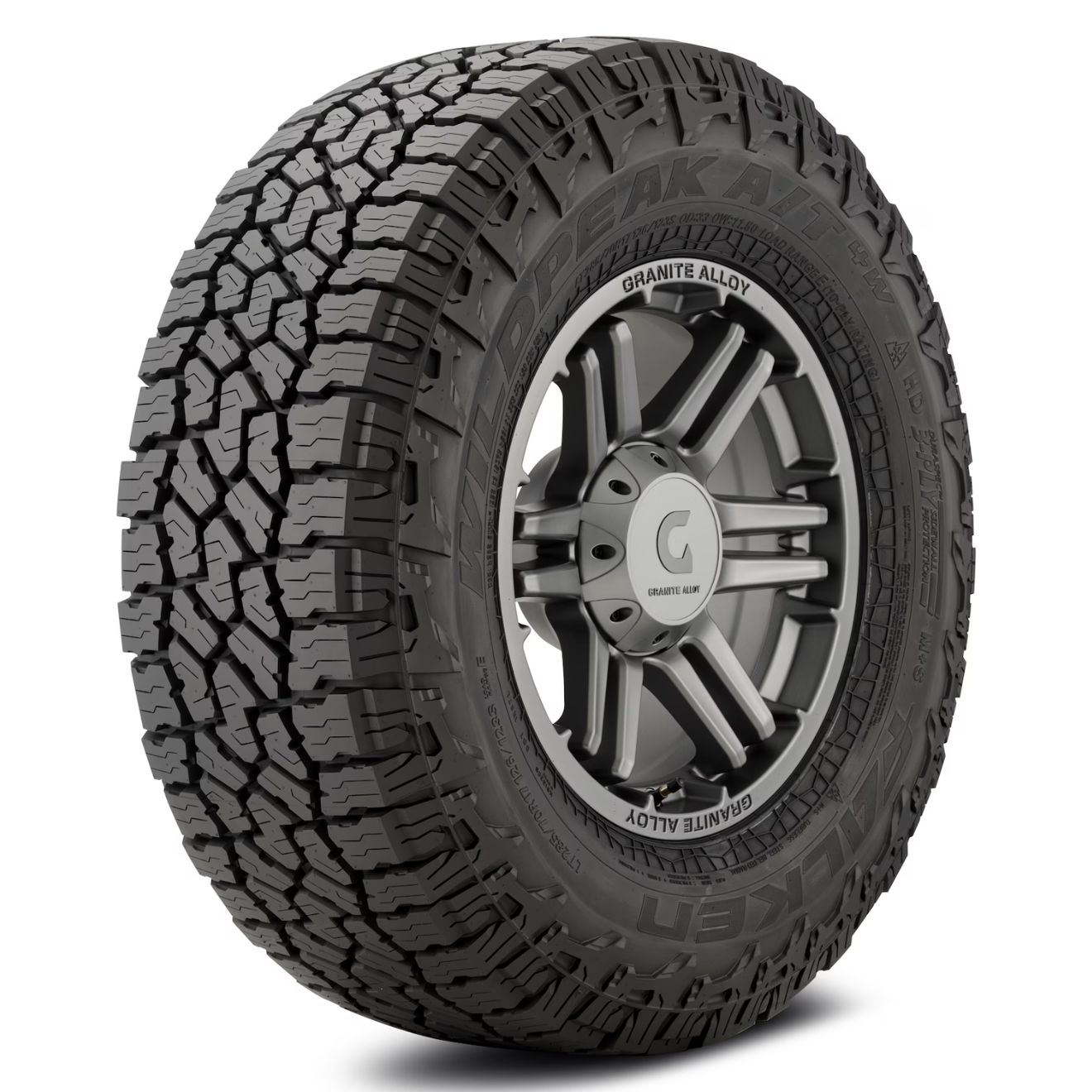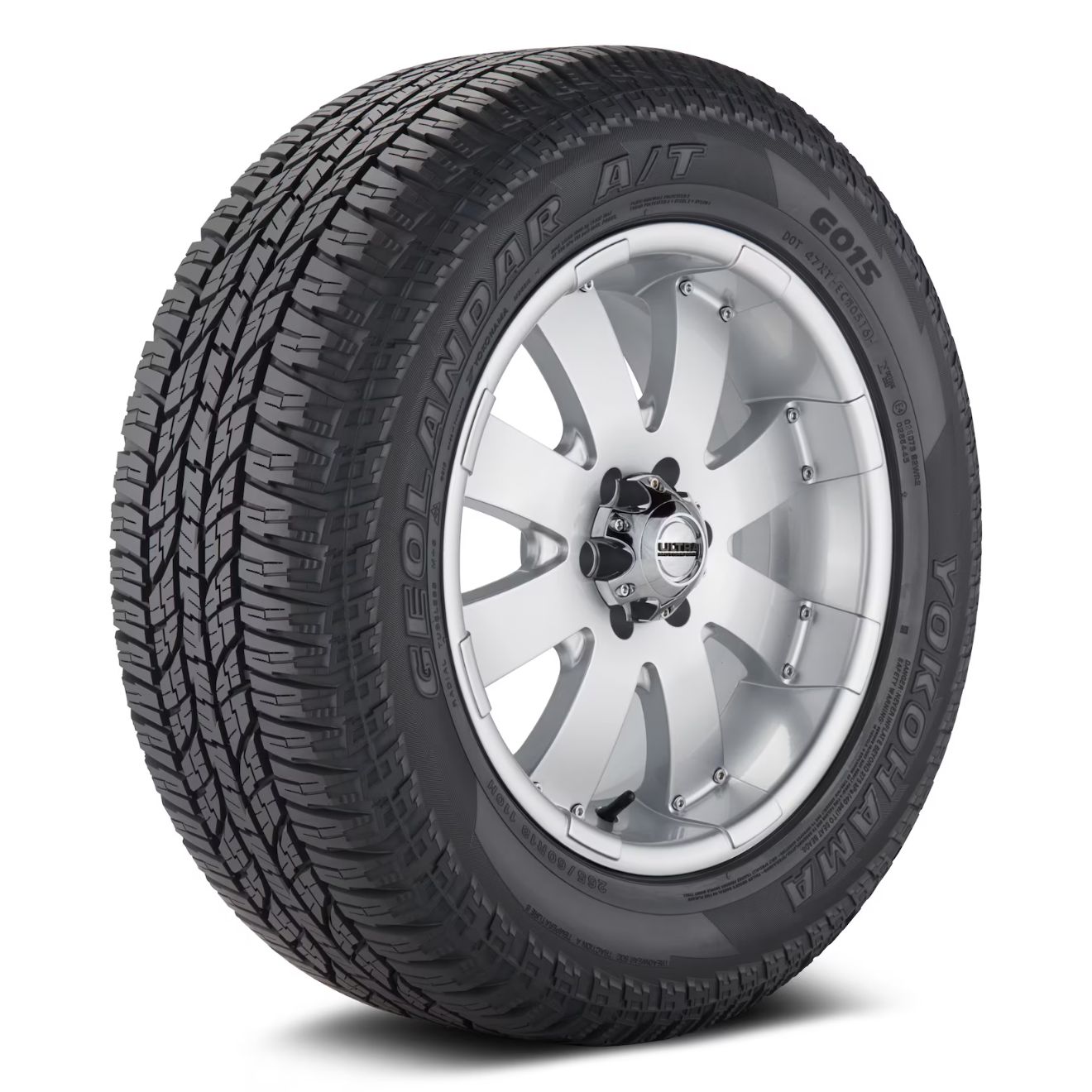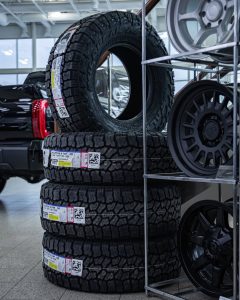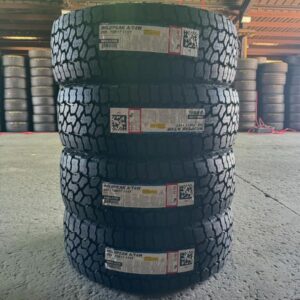Real-world test data, driver impressions, and use-case insights — from a former Bridgestone test engineer.
The Falken Wildpeak AT4W is an Off-Road A/T tire, snow-certified with the 3PMSF rating, and among the most popular choices for light trucks and SUVs across the US and Canada. Since the Falken Wildpeak AT3W is discontinued, understanding the AT4W’s lineage is key: the AT4W refines the proven AT3W formula by focusing on better wet braking, ice traction, and on-road comfort, illustrating Falken’s aim for a truly best-in-class all-around performer. (For the full generational breakdown, see our Falken Wildpeak AT4W vs AT3W guide.) By contrast, the Yokohama Geolandar AT4 slots into the On-Road A/T category — designed for commuters in rainy cities and freeze-thaw regions who want wet traction, quiet comfort, and year-round dependability with A/T styling.
That’s the real choice buyers face — AT4W for the best all-around balance and aggressive capability, or Yokohama AT4 for road-focused comfort and wet-weather security. In the sections ahead, I’ll compare them across dry, wet, snow, and off-road performance. You can also line them up directly in our All-Terrain Tire Decision Tool for quick recommendations tailored by SUV, CUV, or truck class.
Quick Look
The Falken Wildpeak A/T4W is the heavy-duty performer, built for those who prioritize capability. It delivers superior stopping power with a 171-foot wet stop and locks down winter traction with a 69-foot stop in snow and 45-foot stop on ice. The AT4W dominates off-road with aggressive mid-8 scores and provides the planted stability needed for towing. Its comfort is a livable 8.3/10, trading serenity for toughness.
In contrast, the Yokohama Geolandar A/T4 is the quiet commuter’s pick, prioritizing refinement. It offers the quietest and smoothest ride with an 8.5/10 comfort rating. While it is steady in light snow (72-foot stop), its performance is tuned strictly for pavement. The Geolandar’s gentle nature limits it off-road, making it strictly suitable for fire roads and suburban commutes.
Falken Wildpeak A/T4W

Yokohama Geolandar A/T4

Tire Decision Tool
For those in a hurry: this tool makes it easy. Just pick your vehicle and what matters most to you, and it’ll instantly suggest the best tire options.
Raw Test Data
Tire Test Data
Pick categories to show metrics, then open ☰ to pick tires. Optional chart is hidden by default.
Falken Wildpeak A/T3W (Discontinued)
The Falken Wildpeak A/T3W is officially discontinued, but finding remaining stock means you can still buy the performance benchmark for the new AT4W.
Known as the “agile all-terrain athlete,” the A/T3W offered the sharpest dry grip of the entire lineup (126.6 ft stop). The generational transition to the AT4W focused on what to refine: the new model sacrificed a small degree of the A/T3W’s dry sharpness for improved stability under heavy load, and crucially, saw a trade-off in highway comfort to deliver more ruggedness. This strategic sacrifice in comfort was intended to push the AT4W toward serious capability, allowing the Falken Rubitrek AT01 to be introduced to close the market gap for comfort-focused all-terrain drivers. The result was notable improvements over the A/T3W’s “solid” performance in wet braking (shorter stops than the A/T3W’s 176 ft), ice traction, and off-road ruggedness.
Dry Performance — AT4W Steadied, Yokohama More Forgiving
On dry pavement, the Falken A/T4W stops in 131.8 ft with 0.72 g cornering. It presents a slightly softer response than a dedicated road tire, but offers immense stability once set. In contrast, the Yokohama Geolandar A/T4 trails slightly at 139 ft with 0.70 g. It is certainly dependable, but tuned more as a commuter than a corner carver.
A Tacoma driver with the A/T4W noted it was “shockingly good once balanced, lighter than expected on center.” The Geolandar gets love from Tundra drivers calling it “dead quiet, tracks straight, just not built for play.”
From my testing eye, the A/T4W’s heavier shoulders and reinforced structure damp squirm, allowing it to hold a line better once vehicle weight or cargo is added. The Geolandar’s softer shoulders and ribbed design prioritize smoothness, which ultimately caps its agility and responsiveness.
SUVs & Crossovers: Yokohama is the calmer choice if you prioritize comfort.
1/2-ton trucks: A/T4W is steadier when towing or hauling.
3/4-ton & HD trucks: A/T4W clearly wins composure; Yokohama struggles under heavy load.
👉 Verdict: A/T4W steadier when loaded, Yokohama smooth daily driver.
Wet Performance — AT4W Grips Corners, Geolandar Composed
In rain, the Falken Wildpeak A/T4W posts the shortest stop at 171 ft with 0.58 g, a clear advantage demonstrating more silica bite in its compound. By contrast, the Yokohama Geolandar A/T4 stretches the stopping distance to 177 ft with 0.47 g. While the Geolandar is more composed during routine braking, it offers less overall traction feel.
A Bronco owner praised the A/T4W, stating, “wet grip is excellent, never lost trust even in storms.” Geolandar owners, however, noted their tire is “better in the rain than expected, but tuned more for quiet ride than grip.”
The engineering confirms this trade-off: Falken’s high silica and dense siping are designed to aggressively slice through water films for maximum grip. Yokohama leans harder into rib reinforcement and noise pitch tuning, a focus that sacrifices absolute grip for refinement and quiet operation.
Wet Driving Fit
SUVs & Crossovers: A/T4W is the safest choice in storms; Yokohama remains easy and calm.
1/2-ton Trucks: A/T4W is preferred if you frequently tow in the rain.
3/4-ton & HD Trucks: The A/T4W’s heavy-duty carcass steadies best under water load.
👉 Verdict: A/T4W is the confident wet-weather choice, while Yokohama is smooth but not sharp.
Note from the Expert: When it comes to rain, I always emphasize two things: compound grip and water evacuation. You can see the full details in my analysis, but if you take just one thing away, remember that an AT tire’s stiff nature makes achieving top-tier wet performance a constant battle. This is why the question, Are All-Terrain Tires Good in Rain?, requires a nuanced answer that balances tread design against rubber stiffness.
Winter & Snow — AT4W Dominates Packed Roads, Yokohama Limited
The numbers clearly show the split: the Falken Wildpeak A/T4W leads with a snow stop of 69.0 ft and a quick launch in 41.5 ft—excellent for plowed roads. The Yokohama Geolandar A/T4 comes in with a comparable stop distance of 72.0 ft, but its launch is significantly slower at 47.0 ft, making it workable but sluggish out of the hole.
A 4Runner driver with A/T4Ws noted the tire was “predictable in deep snow, no drama.” Geolandar drivers are more reserved, stating it is “fine in light snow, but harder compound shows once tread wears.”
Technically, the A/T4W’s advanced silica keeps the compound pliable in freezing temperatures for consistent grip. Yokohama’s harder tread edges help cut through for braking, but they lose acceleration bite and overall performance once the surface becomes polished or slick.
Winter Fit
SUVs & Crossovers: A/T4W offers the most confidence; Yokohama is fine for light winters.
1/2-ton Trucks: A/T4W is steadier when vehicle weight adds pressure.
3/4-ton & HD Trucks: A/T4W is clearly more stable; Yokohama is not ideal.
👉 Verdict: A/T4W leads in packed snow and overall confidence, making the Yokohama a more limited choice.
Note from the Expert: Our discussions often boil down to the core tradeoff. On one hand, you must understand why all-terrain tires are truly effective in deep snow, but not on ice. On the other hand, you face the 3PMSF Paradox—the hidden cost of that badge. The short answer is: The 3PMSF badge certifies traction, but it costs you durability. Dive into our full analysis on the critical 3PMSF rating for severe winter and off-road service, and its hidden costs, before you risk your rig on the trail.
Ice Performance — AT4W Secures Stops, Yokohama Requires Caution
On ice, the Falken Wildpeak A/T4W stops at 45.0 ft, while the Yokohama Geolandar A/T4 drifts significantly longer to 53.0 ft. This margin is critical—those few feet can make the difference between a controlled stop and sliding into a curb.
A/T4W owners consistently say it “bites on ice better than expected, easy to trust.” Geolandar feedback, however, is clear: “you need more space, not terrible, just not sharp.”
Technically, Falken utilizes siping density and a softer winter compound to keep more rubber edges on the ground. Yokohama, which is tuned harder for long tread life, struggles to create that essential micro-bite needed on an icy glaze.
Ice Driving Fit
SUVs & Crossovers: A/T4W is safest; Yokohama requires caution.
1/2-ton Trucks: A/T4W provides more margin in icy stops.
3/4-ton & HD Trucks: A/T4W is steadier under trailer loads.
👉 Verdict: A/T4W grips best on ice, making Yokohama the least secure choice for these conditions.
Off-Road — Falkens trail strong, Yokohama strictly mild
This is the biggest gap in the comparison. The Falken Wildpeak A/T4W dominates, posting scores of Dirt 8.5 / Sand 8.2 / Mud 8.5 / Rock 8.8. By contrast, the Yokohama Geolandar A/T4 sits much lower, scoring Dirt 6.0 / Sand 5.8 / Mud 5.5 / Rock 5.5.
A Trail4Runner driver on A/T4Ws noted that “slippage was minimal, stayed planted in ruts.” Meanwhile, Geolandar owners generally admit their tires are “fine for fire roads,” confirming they are not built for deep trails.
From the technical side, the Falken carries heavier carcass strength, deeper voids, and staggered shoulders designed to grab loose terrain. Yokohama keeps light ribs and a softer design to prioritize pavement manners, which significantly sacrifices essential bite in mud, sand, and rock.
Off-Road Fit
SUVs & Crossovers: A/T4W shines if you hit trails regularly.
1/2-ton Trucks: A/T4W is for serious off-road; Yokohama is paved-bias.
3/4-ton & HD Trucks: The A/T4W’s toughness handles abuse; Yokohama is not a fit.
👉 Verdict: A/T4W dominates trails, while Yokohama is strictly road-first.
Note from the Expert: Every successful day on the trail is about preparation and physics, because tire longevity is earned, not given. Before you even start, you must master the critical link between tire pressure and load range for every rig to maximize your contact patch. Once moving, remember your ultimate off-road armor is your sidewall protection against the inevitable pinch flat. And finally, your traction on the obstacle is dictated by choosing the right aggressive vs hybrid tread pattern for your terrain. Master those three steps, and your rig will be ready for anything.
Comfort & Noise — Yokohama Church-Mouse Quiet, AT4W Heavier Hum
On-road, the Yokohama Geolandar A/T4 is the clear winner with an 8.5 comfort score. Owners describe it as “dead quiet except for a low tone at highway speed.” The Falken Wildpeak A/T4W follows closely at 8.3. It feels firm but steady—it is quieter than its aggressive looks suggest, though road texture does come through more clearly.
Here’s the trade-off: Yokohama’s rib pattern and advanced pitch tuning are engineered to smooth resonance and minimize noise. Falken tires, by necessity, carry deeper voids designed for off-road bite, which tend to catch road texture and result in a heavier hum. The A/T4W consciously tilts its design more toward toughness and capability than serenity.
Comfort Fit
SUVs & Crossovers: Yokohama is best for absolute quiet.
1/2-ton Trucks: A/T4W is tolerable if capability and towing confidence are the priority.
3/4-ton & HD Trucks: The A/T4W’s firmness is less noticeable on heavy rigs, where noise often blends anyway.
👉 Verdict: Yokohama wins the comfort battle, while A/T4W trades highway calm for all-terrain bite.
Note from the Expert: For years, choosing all-terrain meant accepting noise—a true compromise for off-road grip. That’s why the question, Are All-Terrain Tires Louder than Highway Tires?, used to have a simple “yes” answer. Now, with the rise of on-road models, the core issue has shifted from noise to overall refinement. To fully understand which side of the comfort spectrum you’re buying into, you need to determine Are All-Terrain Tires Good for Daily Driving?—a question that depends entirely on the tire’s construction, not just the name.
Where They Fit Best + Regional Notes
The Yokohama Geolandar A/T4 is best suited for southern and coastal regions where winters are light, highways dominate, and comfort/noise are the top priorities. It’s a great choice for SUVs and commuters who only occasionally encounter gravel roads.
The Falken Wildpeak A/T4W is the serious trail and snow option. It is ideal for the Rockies, Pacific Northwest, and snowbelt states where aggressive winters and challenging off-road routes demand more. This tire is built specifically for 1/2-ton and 3/4-ton trucks that regularly tow or hit rugged trails.
👉 Bottom line: Yokohama wins daily comfort, while the A/T4W takes the crown for heavy-duty snow and trail performance.
Tire Size Selection: The Basics You Can’t Skip
Even the best tread design can’t rescue a tire that’s built too weak. Back when I was testing tires at Bridgestone, I saw all-terrain models that should’ve performed but fell short — simply because the basics (size, load strength, and speed rating) weren’t matched to the vehicle.
P-Metric vs. LT (Light Truck) Tires
The first step is knowing whether you need LT or passenger tires. LT (Light Truck) tires are built with extra reinforcement and stiff sidewalls, designed for towing, hauling, or off-road use. Passenger (P-metric) tires are lighter, smoother, and tuned for daily comfort and fuel efficiency — but they’ll flex more under load.
Understanding Tire Load Range: XL vs. E-Load
Then comes the tire load index and load range — essentially your tire’s strength rating. Here’s where things split between passenger XL and LT E:
XL (Extra Load) is a passenger tire with reinforced sidewalls. It can handle a bit more pressure (~41 PSI) than a standard SL tire and is perfect for SUVs, crossovers, or light trucks that carry extra gear, passengers, or small trailers. XL tires ride softer and quieter than LT options, making them ideal for daily use.
E Load Range is an LT tire class built with a much thicker casing. E-rated tires can handle far more pressure (up to ~80 PSI) and heavier loads, which makes them essential for ¾-ton and 1-ton trucks towing trailers or hauling close to max capacity. The trade-off is weight, stiffer ride, more road noise, and a small drop in fuel efficiency.
Put simply: XL is for “extra luggage and family,” while E is for “truck bed full of bricks or a car trailer.”
Why the Tire Speed Rating Matters for Safety
Finally, don’t overlook the tire speed rating. It’s not just about top speed — it measures how well a tire handles heat and stress at highway pace. Lower ratings (like S) tend to ride softer and last longer, while higher ratings (H, T) feel more stable and responsive under sharp maneuvers. Heat build-up is the silent killer of tires, and speed rating is your safeguard.
Bottom line: Match your tire’s construction (LT vs P-metric), load range (XL vs E), and speed rating to your vehicle’s demands. Get those right, and everything else — off-road grip, winter traction, comfort — will finally perform the way it was designed to.
Final Verdict
For heavier rigs, trail adventures, or snowbelt winters, the Falken Wildpeak A/T4W is the clear choice. It steadies towing, grips confidently on ice and packed snow, and brings real trail toughness without feeling out of control on the highway.
The Yokohama Geolandar A/T4 wins if comfort, quiet, and commuter manners are your top priorities. It’s perfect for Sun Belt and coastal drivers who value pavement refinement but only see occasional gravel or light snow.
👉 Bottom line: Geolandar is the comfort commuter’s A/T, and A/T4W is the snow-belt and trail-ready choice.
Note: If you’re still weighing your options, our full Falken Wildpeak Buyer’s Guide walks through the AT Trail, AT3W, and AT4W in detail, helping you match the right tire to your vehicle, size, and driving style.
Frequently Asked Questions: Falken A/T4W vs Yokohama Geolandar A/T4
Which tire has the best dry grip?
The Falken A/T4W is sharper with a 131.8-ft stop and 0.72 g cornering, compared to the Geolandar A/T4 at 139 ft and 0.70 g.Which tire is best in wet conditions?
The A/T4W stops shortest at 171 ft with 0.58 traction, making it the superior choice over the Geolandar A/T4, which stops longer at 177 ft.Which tire performs best in snow?
The A/T4W leads with a 69-ft snow stop, outperforming the Geolandar A/T4, which stops at 72 ft but has a slower launch speed.Which tire is safest on ice?
The A/T4W grips best at 45 ft, making it significantly safer than the Geolandar A/T4, which trails at 53 ft and requires more caution.Which tire is strongest off-road?
The A/T4W dominates with mid-8 scores across dirt, mud, and rock, while the Geolandar A/T4 is tuned mainly for pavement and gravel (scoring 5.5–6.0).Which tire is quietest on the highway?
The Yokohama Geolandar A/T4 is quietest with an 8.5 comfort score, slightly beating the A/T4W (8.3).Who should choose the A/T4W?
Snow-belt and Rocky Mountain drivers, or those towing and hitting trails, who need stronger winter and off-road performance.Who should choose the Geolandar A/T4?
Commuters in mild climates who prioritize quiet comfort, light winter safety, and occasional gravel use.


